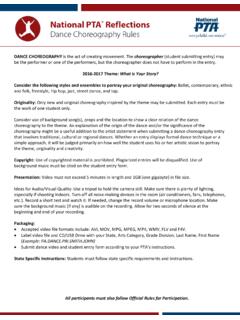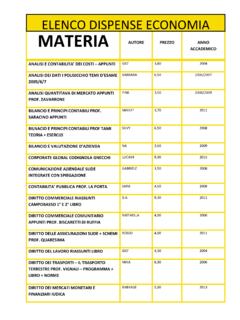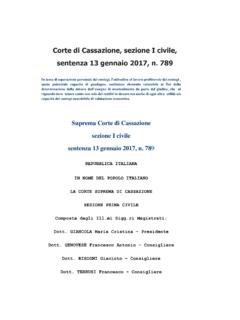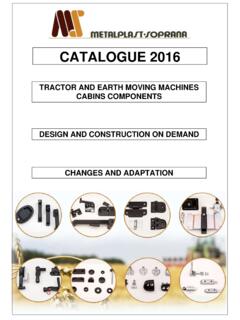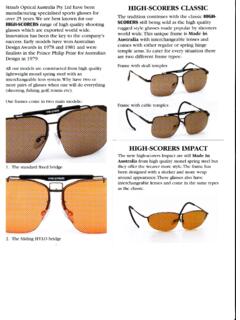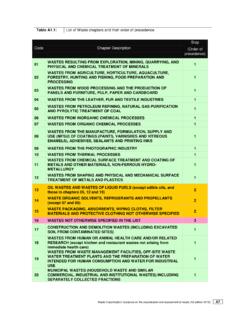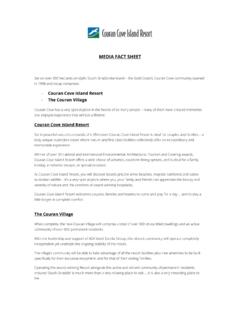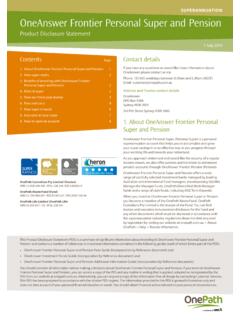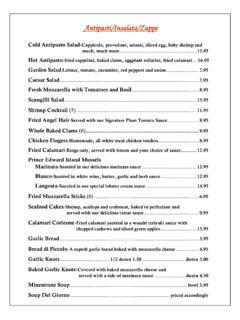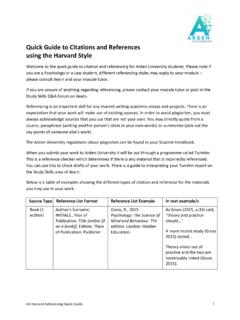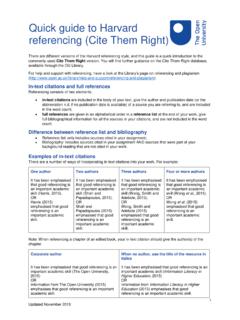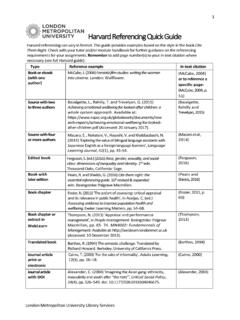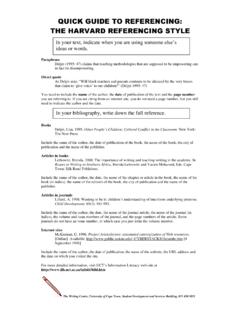Transcription of Harvard Style Reference Guide – Adapted for The IIE
1 IIE Quick Reference Guide 2021 The Independent Institute of Education (Pty) Ltd 2021 Page 1 of 32 Harvard Style Reference Guide Adapted for The IIE IIE Quick Reference Guide 2021 The Independent Institute of Education (Pty) Ltd 2021 Page 2 of 32 Harvard Style Reference Guide Adapted for The IIE1 Different academic institutions, and the faculties within those institutions, make use of different kinds of referencing systems. Given the wide variety of instances in which you may need to Reference , this Guide provides more detail with regards to specific examples of how you might use the Harvard Style of referencing in your academic writing within the context of The IIE. Specific guidance on the principles of referencing , paraphrasing and use of sources may be found in the prescribed text for The IIE s various Academic Literacy modules, but this Guide provides clear examples of the various instances in which you might need to Reference .
2 This document is presented in a table format, with the type of source in the first column, followed by its practical execution in paraphrased and quoted examples, and its final appearance in the Reference list in the last column. Please note that while most of these examples are real titles, many examples refer to hypothetical (imagined) texts to demonstrate the Style . Special notes on referencing are also included at the end of this document to Guide you through some of the more common questions on referencing practice. Please remember that there are a number of ways that each Style is implemented and that even if the faculty you are studying in uses the Harvard Style of referencing , it might still use slight variations of this method. Law students, for example, use a completely different Reference method for law modules, so will only use the Harvard for non-law modules.
3 As such, you should always ensure that you follow the required Style Guide as provided by your faculty/ lecturer. 1 This text has been Adapted for The IIE by Cheryl Siewierski as an additional resource for students and is based on guidance in Chapter 2 and 6 of the following title: Siewierski, C. 2015. An Introduction to Scholarship: Building Academic Skills for Tertiary Study. Cape Town: Oxford University Press Southern Africa. IIE Quick Reference Guide 2021 The Independent Institute of Education (Pty) Ltd 2021 Page 3 of 32 Table of Contents Book (one author) .. 5 Book (two authors) .. 6 Book (three or more authors) .. 7 Books (same author, multiple publications) .. 8 Book (editor/s) .. 9 Book (chapter of edited book) .. 10 eBook (online database/ website) .. 11 Poem (from a book/ website) .. 12 Journal article .. 13 Journal article obtained from an online database/website.
4 13 Newspaper or magazine article (printed and online) .. 14 Website .. 14 YouTube/ TEDx-type videos .. 15 Blog article .. 15 Card and board games .. 16 Online video games .. 16 Artworks/ Images/ figures .. 17 Artworks/ Images/ figures continued .. 18 Online images/ figures .. 19 Tables and diagrams .. 20 Film (cinema, video, DVD format) .. 21 TV series .. 21 Television/ YouTube commercials .. 22 Newspaper, magazine or journal 22 Interviews and personal communication .. 23 Conference proceedings .. 23 Dissertations and theses (unpublished work) .. 24 Organisation as 25 IIE Quick Reference Guide 2021 The Independent Institute of Education (Pty) Ltd 2021 Page 4 of 32 Acts/ Bills/ White and Green Papers of parliament .. 26 Dictionaries and online dictionaries .. 27 Module Outlines/ Guides/ Learn material .. 28 Source integration (multiple sources) .. 28 Secondary referencing .. 29 Special notes on referencing .
5 30 IIE Quick Reference Guide 2021 The Independent Institute of Education (Pty) Ltd 2021 Page 5 of 32 Source In-text Paraphrased In-text Direct Quote Bibliography/ Reference List Book (one author) H ther (2006) argues that psychological and social decisions are of central importance to human brain development. Psychological and social decisions are of central importance to human brain development (H ther, 2006). According to H ther (2006: 6), .. the most important decisions a human being can make in the course of his life are psychosocial in nature.. [T]he most important decisions a human being can make in the course of his life are psychosocial in nature (H ther, 2006: 6). H ther, G. 2006. The compassionate brain: How empathy creates intelligence. Boston: Trumpeter. Author surname (comma); Initials (full-stop between initials) (full stop); Year (no brackets) (full stop); Name of book (italics) (no unnecessary capitalisation in title sentence case) (full stop); Edition number (if not first edition) in numerical form and superscript ordinal, and lowercase ed (full stop); Place of publication (city, not country) (colon); Publisher name (full stop).
6 IIE Quick Reference Guide 2021 The Independent Institute of Education (Pty) Ltd 2021 Page 6 of 32 Source In-text Paraphrased In-text Direct Quote Bibliography/ Reference List Book (two authors) Strunk and White (2000) argue that overwriting should be avoided, since it makes understanding and engaging with texts difficult for readers. Overwriting must be avoided, since it makes understanding and engaging with texts difficult for readers (Strunk & White, 2006). Note: When the Reference forms part of the text when referencing , the use of the ampersand (&) is not permitted, as in the first example above. However, when the authors are not used as part of the text, and in brackets instead, the ampersand (&) should be used. Strunk and White (2000: 72) argue that [r]ich, ornate prose is hard to digest .. It is best to steer clear of overwriting, since [r]ich, ornate prose is hard to digest (Strunk & White, 2000: 72).
7 Strunk, W. and White, 2000. The elements of Style . 4th ed. Massachusetts: Allyn & Bacon. Author surnames, initials (joined by and , not & ) (full stops between initials); Year (no brackets) (full stop); Name of book (italics) (no unnecessary capitalisation in title sentence case) (full stop); Edition number (if not first edition) in numerical form and superscript ordinal, and lowercase ed (full stop); Place of publication (city, not country) (colon); Publisher name (full stop). IIE Quick Reference Guide 2021 The Independent Institute of Education (Pty) Ltd 2021 Page 7 of 32 Source In-text Paraphrased In-text Direct Quote Bibliography/ Reference List Book (three or more authors) First use .. Davis, G., Pecar, B., Santana, L. and Burke, A. 2014. Statistics for the social sciences using Excel : A first course for South African students. Cape Town: Oxford University Press Southern Africa.
8 Author surnames, initials (joined by and , not & ) (full stop after last set of initials); Year (no brackets) (full stop); Name of book (italics) (no unnecessary capitalisation in title sentence case) (full stop); Edition number (if not first edition) in numerical form and superscript ordinal, and lowercase ed (full stop); Place of publication (city, not country) (colon); Publisher name (full stop). Davis, Pecar, Santana and Burke (2014) assert that all fields that engage in data collection do, in essence, make use of statistics. All fields that engage in data collection do, in essence, make use of statistics (Davis, Pecar, Santana & Burke, 2014). Note: The first time that you mention a source with multiple authors (three or more), all authors names must be used. Davis, Pecar, Santana and Burke (2014: 3) suggest that if the work involves creating or collecting data, .. then statistics will typically be involved in some way.
9 [I]f the work involves creating or collecting data, .. then statistics will typically be involved in some way (Davis, Pecar, Santana & Burke, 2014: 3). After first use .. Davis et al. (2014) .. (Davis et al., 2014). Note: You may use the first author s surname and the abbreviation et al. ( and others ) to represent the additional authors after first (full) use. Note that et al can be used for in-text citations, but it may not be used as part of a bibliography or Reference list. The phrase et al. should also always be followed with a full stop regardless of its position in a sentence. Davis et al. (2014: 34 35) .. (Davis et al., 2014: 34 35). IIE Quick Reference Guide 2021 The Independent Institute of Education (Pty) Ltd 2021 Page 8 of 32 Source In-text Paraphrased In-text Direct Quote Bibliography/ Reference List Books (same author, multiple publications) Different years .. Smith, 2015a. Approaching pedagogy the wrong way around.
10 Pretoria: InventaPress. Smith, 2015b. Changing policy paradigms. 2nd ed. Cape Town: Education House. Smith, 2011. Turning school policy on its head. Sandton: Fairbooks. Author surnames, initials (joined by and , not & ) (full stop after last set of initials); Year (no brackets) (full stop); Name of book (italics) (no unnecessary capitalisation in title sentence case) (full stop); Edition number (if not first edition) in numerical form and superscript ordinal, and lowercase ed (full stop); Place of publication (city, not country) (colon); Publisher name (full stop). Note: When the same author has more than one text but in different years then arrange these chronologically. An expert in the field of teaching and learning, Smith (2015a; 2011) has repeatedly argued .. Smith (2015a: 7; 2011: 3) has repeatedly argued that schools could be more successfully transformed if we approach them the wrong way around.

